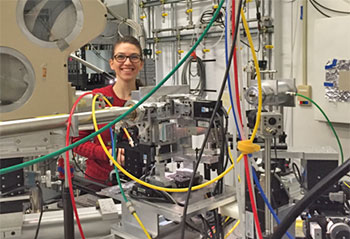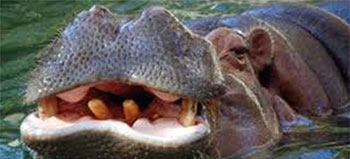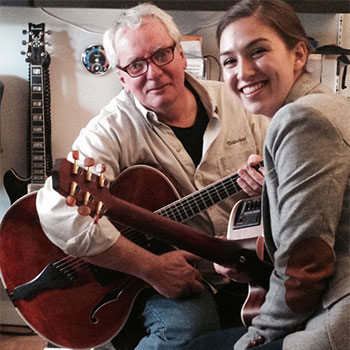Chemical Composition of History
History may have been made by rulers and won on the battlefield. But it has also been captured by painters, moulded into pottery and carved into intricate sculptures. Historians study these various objects in an attempt to shed some light on the lives and times of people from a bygone era. But what can a chemist teach us about history?
 Madalena Kozachuk, a Ph.D student in Dr. T. K. Sham's laboratory at The University of Western Ontario, originally wanted to be a dancer. She chose to follow, in her words, "a more pragmatic and economically viable path."Now, her work as a chemist at the intersection of science and history is enabling researchers to travel back in time.
Madalena Kozachuk, a Ph.D student in Dr. T. K. Sham's laboratory at The University of Western Ontario, originally wanted to be a dancer. She chose to follow, in her words, "a more pragmatic and economically viable path."Now, her work as a chemist at the intersection of science and history is enabling researchers to travel back in time.
Different combinations of elements such as carbon and hydrogen give rise to a variety of materials such as wood, clay and iron. When a potter in ancient Egypt took a handful of clay, moulded it into a pot and baked it in an oven, chemical properties of those elements were changed. By using sensitive instruments to detect these chemical properties, Madalena can indirectly determine the age of the object, the various materials used and how those materials were combined to create the object. Essentially, she uses a synchrotron accelerator to shine a beam on the object and then scans it with a special microscope to generate a three-dimensional image. The beam is a stream of charged particles called electrons that are like tiny balls. When electrons come into contact with different elements present in the object, they bounce back in patterns that are characteristic of those elements. The three-dimensional scans help Madalena examine the distribution of those elements across the whole sample.
One of the more interesting applications of her research is determining ancient trade routes. She explains, “Suppose through chemical analysis I discover that the type of iron used in a medieval English sword was only found in a particular mine in, say, China. In conjunction with existing historical texts, I can deduce the existence of a trade route between China and England during medieval times."
Given the preciousness of historical artifacts, museums and conservation institutions take meticulous care in maintaining them. But to study the history, ensure authenticity or assess possible damage, artifacts need to be sampled. "For my work, all I need sometimes is an exceedingly small piece of the object, barely the size of a tiny fingernail", Madalena says. Her methods ensure that these objects endure for decades to come.
Even within Western's strongly inter-disciplinary research atmosphere, Madalena's degree is a niche combination of chemistry, art history and archaeology. She attributes her ease of seamlessly integrating divergent disciplines to her upbringing. "My mother is a professional musician while my father constructs armoured military vehicles", she explains. "So while I am heavily drawn towards the arts, I am equally at home in the world of scientific analysis". During the last year of her undergraduate double major in chemistry and art history here at Western, she worked with Dr. Ronald Martin, a professor of chemistry. She used a variety of X-ray techniques to assess the wear-and-tear of wooden prayer beads, which were obtained from the Thomson Collection of the Art Gallery of Ontario. "That's when I knew what I wanted to do for my Ph.D", she reminisces.
 For her PhD project, co-supervised by Dr. T. K. Sham and Dr. Ronald Martin from Chemistry and Dr. Andrew Nelson from Anthropology, Madalena is currently studying bone and teeth samples from coastal communities in Peru and ivory samples retrieved from Alaska.
For her PhD project, co-supervised by Dr. T. K. Sham and Dr. Ronald Martin from Chemistry and Dr. Andrew Nelson from Anthropology, Madalena is currently studying bone and teeth samples from coastal communities in Peru and ivory samples retrieved from Alaska.
She elaborates, "The raw material for ivory is essentially the same as teeth. Bromine, an element that we believe could be crucial for cell growth and development, is found in these biological materials. Depending on the animal's habitat for example, a hippopotamus or an elephant, the distribution and concentration of bromine within teeth indicates the animal’s environment. "I am hoping to determine whether the ivory sample is marine or terrestrial in origin", she explains. Apart from the historical importance of her research, it impacts the academic, museum and border control communities that follow the Ivory trade laws listed under the Convention on International Trade in Endangered Species (CITES).
 While spanning academic disciplines has become second nature for Madalena, she also spends her time exploring other extracurriculars. She is a certified Pilates instructor and some time back, released an album of songs with her guitar teacher. "I regularly play and perform covers and original works", she informs.
While spanning academic disciplines has become second nature for Madalena, she also spends her time exploring other extracurriculars. She is a certified Pilates instructor and some time back, released an album of songs with her guitar teacher. "I regularly play and perform covers and original works", she informs.
With the expertise that she is gaining, Madalena plans to pursue research positions at major art institutions across North America and abroad. Currently, she is working with her colleagues to organize a conference, bringing together chemists, curators, art historians, and archaeologists across Canada to explore and present recent advancements in the field of technical art history. Until then, Madalena continues to shine light as a chemist in order to unveil compelling historical tales.

